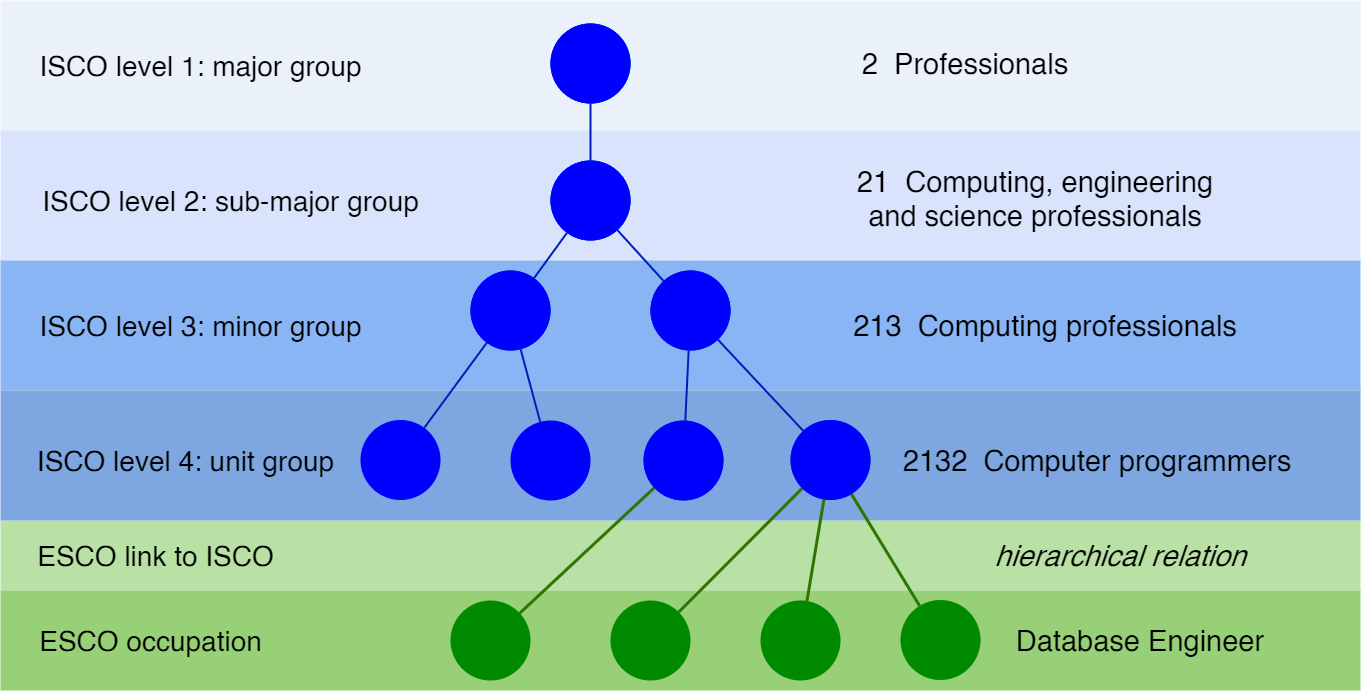Description
Classify Multilingual Labour Market Free-Text to Standardized Hierarchical Occupations.
Description
Allows the user to map multilingual free-text of occupations to a broad range of standardized classifications. The package facilitates automatic occupation coding (see, e.g., Gweon et al. (2017) <doi:10.1515/jos-2017-0006> and Turrell et al. (2019) <doi:10.3386/w25837>), where the ISCO to ESCO mapping is exploited to extend the occupations hierarchy, Le Vrang et al. (2014) <doi:10.1109/mc.2014.283>. Document vectorization is performed using the multilingual ESCO corpus. A method based on the nearest neighbor search is used to suggest the closest ISCO occupation.
README.md
labourR 
The goal of labourR is to map multilingual free-text of occupations, such as a job title in a Curriculum Vitae, to hierarchical ontologies provided by ESCO, the multilingual classification of European Skills, Competences, Qualifications and Occupations, and ISCO, the International Standard Classification of Occupations.

Fig.1 - ESCO is mapped to the 4th level of the ISCO hierarchical model.
Computations are vectorised and the data.table package is used for high performance and memory efficiency.
See Articles section for details.
Installation
You can install the released version of labourR from CRAN with,
install.packages("labourR")
Examples
library(labourR)
corpus <- data.frame(
id = 1:3,
text = c("Data Scientist", "Junior Architect Engineer", "Cashier at McDonald's")
)
- If the ISCO level is specified, the top suggested ISCO group is returned.
num_leavesspecifies the number of ESCO occupations used for the k-NN classifier to perform a plurality vote,
classify_occupation(corpus = corpus, isco_level = 3, lang = "en", num_leaves = 5)
#> id iscoGroup preferredLabel
#> 1: 1 251 Software and applications developers and analysts
#> 2: 2 214 Engineering professionals (excluding electrotechnology)
#> 3: 3 523 Cashiers and ticket clerks
- If the ISCO level is not specified, the top num_leaves, in this case 5, suggested ESCO occupations are returned for each id,
classify_occupation(corpus = corpus, isco_level = NULL, lang = "en", num_leaves = 5)
#> id conceptUri preferredLabel
#> 1: 1 258e46f9-0075-4a2e-adae-1ff0477e0f30 data scientist
#> 2: 1 1562c7a3-c7d9-419d-b9b6-db26610bcf84 data warehouse designer
#> 3: 1 f470b785-643c-46f9-8b31-6085427ab7b8 aeronautical information specialist
#> 4: 1 7086d0ca-1e77-4690-89c9-7ed1a0478fa3 data quality specialist
#> 5: 1 d3edb8f8-3a06-47a0-8fb9-9b212c006aa2 data analyst
#> 6: 2 76abbb82-c103-4d7a-a4c0-14dba4d6199a commissioning engineer
#> 7: 2 c8fa93eb-7c2c-42c3-b135-c2e825a6615e test engineer
#> 8: 2 e12f08fb-4748-4388-9489-b647df60332a hydropower engineer
#> 9: 2 9dbbeb2c-0d51-4c03-8ef6-8dfa7360db22 ship assistant engineer
#> 10: 2 2f26a52b-cf45-4282-9138-478252161f00 food production engineer
#> 11: 3 3f32394b-f1b1-48ef-96ee-74405fb7c6b6 lottery cashier
#> 12: 3 961cbd1f-2a9b-4756-b227-67a1c23c94b6 casino cashier
#> 13: 3 2ff9e53c-6e7f-42af-8d71-b5dd7f283089 bank teller
#> 14: 3 b7fc1cd1-0d6d-4e9e-8a9f-c3270201be81 foreign exchange cashier
#> 15: 3 2b871272-bd61-4206-bd1a-0b96d7023098 cashier